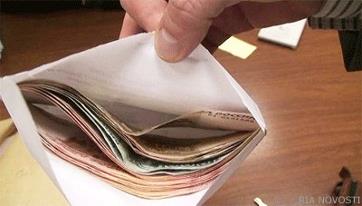Russia’s Widening Wealth Divide Poses Risks to Central Bank

(Bloomberg – bloomberg.com – Andrey Biryukov – October 19, 2016)
The Bank of Russia is discovering yet another downside to how little is left of the country’s middle class.
The central bank has warned that its ability to steer inflation is at risk from growing wealth inequality and the disappearance of the middle-income households that are the most sensitive to interest rates and prices. Earnings and domestic demand are still withering at a pace unprecedented under President Vladimir Putin. Retail sales dropped in September for a record 21st month, while real disposable incomes fell an annual 2.8 percent, the Federal Statistics Service in Moscow said on Wednesday.
Consumption has been obliterated as wages couldn’t keep up with the surging cost of living. That’s pushed 14 million Russians — a population bigger than Illinois — out of the middle class since the economic slump started two years ago, according to Sberbank CIB’s latest survey of shoppers. The downfall of a group that rose to prosperity during the oil boom marks a historic reversal after it doubled in size under Putin. Many of them now rely on government programs to complement their dwindling incomes and have become more vulnerable to changes in fiscal policy.
“The decline of the middle class is bad for control over inflation, because risks from fiscal policy are higher,” said Oleg Kouzmin, a former central bank adviser who’s now chief economist for Russia at Renaissance Capital in Moscow. “Demand will be more sensitive to budget decisions” since any assistance will have an immediate effect by touching off spending by poorer households, he said.
While the widening rich-poor divide crimps consumption, and the International Monetary Fund has found that avoiding the “hollowing-out” of the middle class benefits economic growth, the impact of income polarization on central bank policy is less obvious.
Deeper social inequality weakens the price elasticity of demand and complicates the task of controlling inflation, according to the Bank of Russia. Less-well-off families, usually without savings and little access to loans, spend primarily on basic necessities and hardly react at all to changes in interest rates, it said. Wealthier households, on the other hand, are unresponsive because they spend such a small share of their incomes on staples.
‘Most Sensitive’
“Middle-income families are the most sensitive to changes in interest rates and consumer prices, which in turn encourages producers to adjust to changes in their demand,” the central bank said in its draft guidelines for 2017-2019. “Economic policy that promotes a more even distribution of incomes in society will create the conditions not only for balanced development and social stability but will also enhance the effectiveness of signals from monetary policy.”
Risks already abound for the central bank. Its credibility is on the line after price growth overshot forecasts for a fourth consecutive year in 2015.
Policy makers, concerned they won’t deliver on their 4 percent inflation target by end-2017, have pledged to keep rates on hold through the rest of the year after reducing their benchmark to 10 percent in two steps in 2016.
Derivatives traders scaled back their bets for a rate cut in the next three months. Forward-rate agreements indicated eight basis points of easing on Wednesday, compared with this month’s high of 44 basis points.
Prosperity Bubble
Putin ushered in an era of affluence before a conflict in neighboring Ukraine erupted in 2014 and oil prices collapsed, stoking the country’s worst currency crisis since the government’s debt default in 1998.
Between 2000 and 2013, the middle class — defined as those with per capita consumption equal to or above $10 a day — doubled to more than 60 percent of the population, according to the World Bank. The lender estimates that by 2010, the middle class controlled 74 percent of total household income and 86 percent of consumption.
Sberbank CIB’s survey of the “the Ivanovs,” using a common last name to describe the typical shopper, found that the share of Russians who consider themselves middle class was at 51 percent last quarter, down from 61 percent two years earlier. As wages fall in line with inflation, the middle class is unlikely to shrink further, according to the investment-banking arm of Russia’s biggest lender.
Yet its proportion may already be less, said Igor Polyakov, an analyst at the Center for Macroeconomic Analysis and Short-Term Forecasting in Moscow, who puts the share at as low as 32 percent, down from about 40 percent in 2014. The middle class is set to contract in 2017-2018 and won’t start to recover until the following two years, he said.
A poll by the state-run All-Russia Center for the Study of Public Opinion released on Wednesday showed that 60 percent of respondents believe it’s not a good time to make large purchases and 80 percent say the same is true of taking out loans. Sixty-one percent of Russians think that right now, it’s best to spend at little money as possible and save for the future instead, according to the Sept. 24-25 survey of 1,600 people, which had a margin of error of no more than 3.5 percentage points.
“A shift to a savings-oriented model won’t soon result in greater confidence in the future,” Polyakov said. “Because of the contraction in the middle class, there’s no reason to expect a rebound in sales of costlier goods.”
Article ©2016 Bloomberg L.P. All Rights Reserved. Article also appeared at bloomberg.com/news/articles/2016-10-18/russia-s-incredible-vanishing-middle-class-ruffles-central-bank
